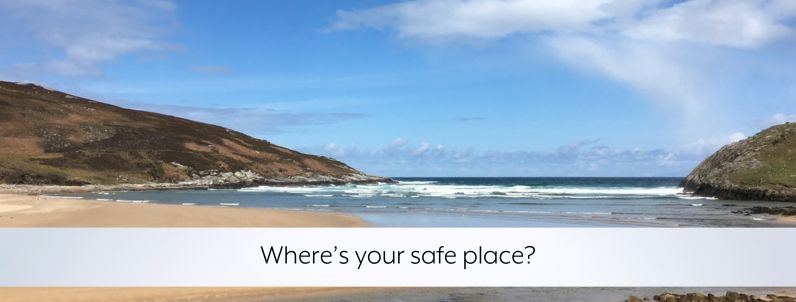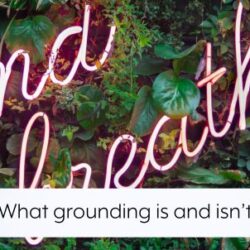
I was travelling into London last week. By contrast, I live in a fenland market town. By contrast, therefore, London is Big. Too Big (for me). It’s noise and bustle and cars and grime and horns and grey and shiny, and it’s busy, busy, busy.
As we came out of our hotel, I realised that you couldn’t see the sky unless you tilted your neck exactly vertical. It’s not what I’m used to.
Even coming into London, I veer towards the edge of my window of tolerance. I just want everyone to quieten down and slow down. It’s part of me being a grade A introvert. And it makes me realise what my coping strategies are based around and what I need to feel safe.
I need openness and sky. I need countryside and earth and breeze. I need crunchy twigs underfoot and birds all around. I need quiet. What do you need?
Years ago, when I first started therapy, I was invited to imagine a safe place. I didn’t understand the concept at all.
First off, I didn’t understand how powerful positive visualisations can be. Secondly, I didn’t know how to feel safe. And thirdly, I didn’t have anywhere that I could summon to mind and feel positive about. Bummer.
To hide my feeling of inadequacy, I dismissed it as therapy-geekery. But it had piqued my curiosity.
What would it be like to feel safe, and what it would be like to have a place that was so nourishing and additive that even just thinking about it could slow your heart rate and soothe your agitation? It was a cool idea even if it felt at that time impossible.
Fast forward to today.
I have a dozen places now that I can call to mind and they ooze inside me with sticky toffee goodness.
There’s one place at the foot of a mountain. The air is so clean and the only sounds are of stags baying. Trickling, pure-clear water ripples downstream over a million combinations of rock and stone and pebble. Everything is so still. Everything is so sweet.
It’s glorious emptiness for miles around, the mountain on one side, the hill on the other, the river in between, and the air sings as with middle C.
And there it is, in my mind’s eye, and I well up inside with the goodness of it, and it’s safe, and it feels safe, and at last, after all these years, I’ve found a safe place visualisation that actually works.
But I had to go there first. I had to experience it. My imagination wasn’t enough, because it was hedged in by the not-knowing.
I’ve been alive over 40 years, but trauma hijacks your eyes and your ears and your nose and your feet and all you can focus on is danger and threat and malice and pain. And you can’t feel the turf below you, you can’t hear the goldfinch tribble, you can’t smell the trees and the moss and the bracken and the sea air.
You forget how to be alive. You just focus, always, on danger, and it’s all you can do to get through the next day.
So it’s taken a long time for me to have safe places. I’ve had to seek them out. And then I’ve had to practice, mindfully, being there and noticing.
I’ve had to inhabit my body and my senses and actually learn what it’s like to suck in all the goodness around me. I’d had to switch off my radar and zoom into the reality of safety around me.
I’ve had to break the habit of looking, always looking to the periphery for threat, and focus on the immanent: the ‘what is’ around me, rather than the ‘what might be’.
Some people call that being present, or being mindful. Whatever you call it, it doesn’t work unless you actually do it.
You have to start training your brain to focus on what’s safe and good and pure, rather than what’s not. It’s a tough habit to crack. But it changes everything. Because you can begin to actually enjoy life, rather than feeling so afraid all the time.
Recovery from trauma is so much about learning to feel safe. It took me years to find it, and even longer to learn how to do it, but at least I know now what a safe place is, and at last I know how to feel safe too.
Where’s your safe place? If you haven’t got one, what plans can you put in place to begin to find one?



8 Comments
For many years I struggled to find a safe place that wasn’t so far inside my head that no-one could reach me. Like you, safe for me is tied up with open spaces and lack of people.: but also with the tiniest of spaces: somewhere I can curl up small and quiet and not be found. I have a couple of physical places now that mean safety and peace for me: but I’ve also found someone who is a safe haven for me. I still have my inner world, and still retreat there when the outside is too overwhelming, too big and too full: but that happens less often, and for shorter periods than it did before. I’m slowly learning what ‘safe’ really feels like: and that it can be ‘safe’ just to be me.
Thank you; you’ve reminded me to practise mindfully being. I know it works and I need more practice. When I went to bed I remembered the safe place I imagined when I was 8 years old. Me and my knitted bunny on a houseboat every night. How clever of a child’s mind to do that. I still have the bunny and we went there again.
It wasn’t just me then, in London, nearly crying from the stressful experience before I got to Amnesty! Thankfully I have plenty of countryside near me where I can practise being and feeling safe.
Thank you for doing this blog Carolyn; it’s really helpful.
I struggle with London too – it also took me a huge amount of energy staying grounded enough to tolerate it last week, and that was before we even made it to Amnesty.
It’s interesting – the same sorts of places that you mention are often what feel safest to me too. No (or very few) people, outdoors, space, quiet. As a child I used to imagine different houses I could live in. I had various designs in mind (some of them probably more structurally sound than others), but what they had in common was different ways of making sure that nobody could get in unless I wanted them there. These days, my (imagined) safe place incorporates both things – it’s a tree-house, in a remote area with mountains and fresh air, but comforting things inside and protective elements so that only me, and anyone safe I want with me, can find it, let alone access it. Made up of things that I have come to experience as safe in real life, all combined together and a place to ‘go’, to imagine and feel genuinely safe.
I haven’t yet been able to come up with a safe place. I was hunted in the woods as a child and so being outside is a dangerous place to me. Which is a pity as I loved being outside as a child. I remember climbing a tree and listening to my abuser yell my name into the woods, as he searched for me. It still gives me chills. I prefer quiet places like libraries. I’ve always been safe in a library, where the place is filled with books to read. Reading was always my escape of choice. When I was reading I was in another world. I will have to practice mindfully looking for safe places.
Even safe places were eventually destroyed either by myself or others (self fulfilling). So I kept running. Now at 53, having left an abusive relationship, suffered a stroke and lost my job as a consequence, I am trying to rebuild my life, again. Will I continue to run, I don’t know. What I do know is that after years of therapy and qualifying as a Psychodynamic Attachment Theory psychotherapist, I hope to continue mindfully “walking” through life with my eyes wide open. And I do this with the non-judgemental, forgiving, compassionate, loving help and support of friends, therapist and most importantly myself. Without a shore we are lost in an ocean.
Like you it’s taken me over 45 year’s to learn that there was such a thing as a safe place but for me it’s the Lake District it’s like I’m a totally different person there I can walk around in the middle of a wood at I’m not frightened of anything it’s so peaceful. I’ve also learned it’s a place I can go to in my head when things are getting on top of me.
My safe space is my cubicle at work. Nothing bad has ever happened to me in an office. In an office, things are orderly, clean and make sense. You know what you are supposed to do. There’s stability and predictability. No one yells. Someday, I’ll get to the point where I can enjoy wide open spaces and nature. For now, I just enjoy the heck out of my cubicle.
It was the Church, since I was a child. Then, decades later, when its abuses were exposed, it symbolised danger. Luckily, I could still cling to both a sword, and a shield. The sword is to give. The shield is to forgive.